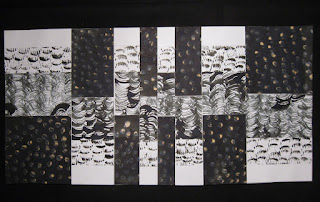
The Golden Section:
drawing on squared paper and sample with decorated papers using tonal grading
------------------------------------------------------------------------------------------------
Sample 1
four patterned papers put into a gradual tonal "column"
first column: 2cm
second column: 3 cm
third column: 5 cm
fourth column: 8 cm
Sample 1
Sample 2
Sample 1 cut into 4 sections vertically using the same measurements than in sample 1
Sample 2
Sample 3
Strips from sample 1 cut using the Fibonnacci sequence, flipped and glued down, starting with the widest section
Sample 3



Sample 4
one patterned and one plain paper cut into strips using the Fibonnacci sequence. The strips were arranged alternatively starting with the widest strip of the patterned paper and the smallest strip of the plain white paper
Sample 4
Sample 5
Sample 4 cut at right angles . These strips were arranged onto a plain background, leaving gaps of the Fibonnacci series of proportions

Sample 5
Sample 6
The strips of sample 5 were flipped and glued down.
I made one mistake at the beginning of this sample series: for more contrast, I should have taken a black background for gluing down the stripes or I shouldn't have taken a plain white paper but a decorated one instead. Thus I would have achieved a more interesting sample
Sample 6
Sample 7
A Fibonnacci block using 5 strips in tonal order was copied and one copy was placed up-side-down next to the original.

Sample 7
Sample 8
Equal strips were cut from the above block and alternate strips were moved slightly up to form a fractured design

Sample 8
Sample 9
Strips from block 7 were placed in the same formation as strips for log cabin patchwork
Sample 9
Sample 10
above block was cut into stripes of 3cm width that were then flipped again and reassembled


Sample 10



























